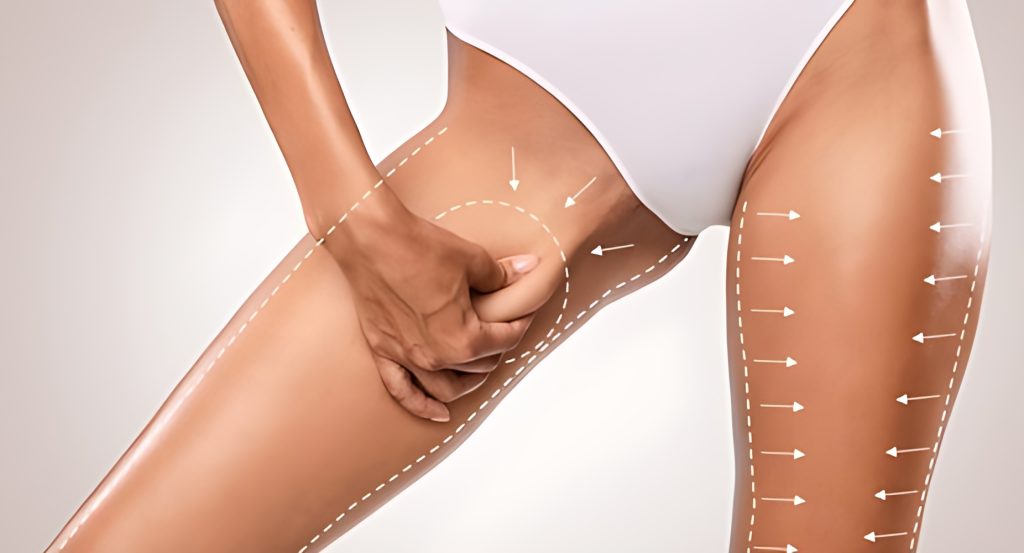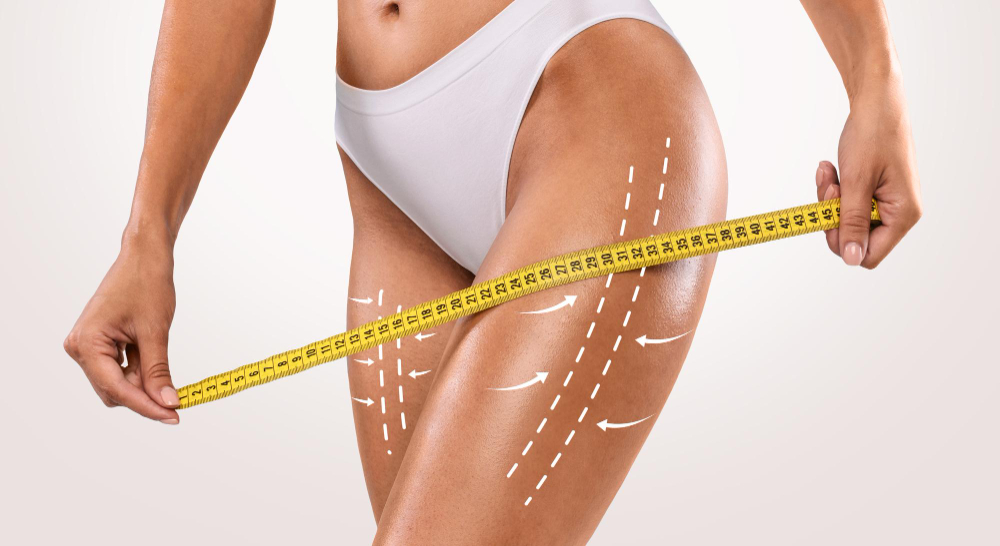Thighplasty (Thigh Lift)
A thigh lift, also known as thighplasty, is a cosmetic treatment that enhances the shape and firmness of your thighs. This procedure involves eliminating excess fat and droopy skin. Individuals who have experienced significant weight loss often opt for a thigh lift. The complete outcomes of a thigh lift are typically visible around six months following the surgery.

Why is a thighplasty performed?
Thighplasty aims to improve the look of your upper legs. It targets excess skin and stubborn fat that cannot be effectively tightened or reduced through diet and exercise. By undergoing a thigh lift procedure, you can achieve a remarkable decrease in sagging skin and fat on your thighs.
Types of Thigh Lifts
There are three types of thighplasty
- A procedure called inner thigh lift focuses on tightening and improving the appearance of the skin on the lower part of the inner thigh.
- A medial thigh lift focuses on tightening the skin and reducing fat in the upper section of the inner thigh.
- A bilateral thigh lift specifically targets the skin located on the front and outer areas of the thigh.
Typically, inner and medial thighplasty surgeries are done as outpatient procedures. However, a bilateral thigh lift may necessitate a hospital stay lasting overnight.
Who is a candidate for a thigh lift?
If you meet the following criteria, you may qualify for thigh lift surgery:
- Don’t smoke.
- If you have any pre-existing medical conditions that are effectively controlled, such as diabetes, or if you do not have any conditions that could hinder your recovery process.
- I have successfully kept my desired weight for a year and have no intention of further weight loss.
In order to determine if you are suitable for a thigh lift surgery, a doctor specializing in surgery will assess your overall health and medical background.

Before Your Thigh Lift
Your thighs will undergo a thorough examination by your plastic surgeon, which will include checking for any problems with your range of motion. Additionally, they will inquire about any previous injuries to or surgeries on your thighs.
Your surgeon will evaluate your general well-being and check for any indications that may lead to complications, such as:
- Bleeding or blood clotting disorders.
- Blood pressure.
- Previous surgical procedures have left behind scars with negative consequences in medical history.
You will also discuss with your plastic surgeon:
- The concerns you have regarding the presence of extra skin on your thigh area.
- There are alternative methods available for getting rid of excess skin, such as liposuction.
- What you hope to achieve and what your expectations are for the surgery.
- Your thigh scar’s length and placement can be indicated by your surgeon using a medical pen, providing you with an idea of what it will look like in advance.
- The risks and benefits of thigh lifts.
During the initial consultation, your surgeon will discuss with you the necessary preparations for your thigh lift procedure.
- Which medicines to avoid and when you should take your prescribed medications.
- Proper washing of your incision.
- Any limitations on eating or drinking the night prior to the surgical procedure.
- Quitting smoking.
What’s the procedure like?

Prior to undergoing a thigh lift surgery, you will be advised to refrain from taking medications that can lead to increased bleeding, which may include aspirin, specific supplements, and anti-inflammatory drugs like ibuprofen. Additionally, your surgeon may request a medical examination to confirm your suitability for the procedure.
During the procedure, you will be given general anesthesia. The surgeon will make incisions according to the type of thigh lift you have chosen. They will then remove extra skin and fat tissue and use stitches to close the incisions.
Typically, it takes around 2 hours to finish the overall procedure. However, considering the time spent in pre-op and post-op, you should anticipate that the entire process will occupy a significant portion of your day.
Having someone accompany you both before and after the surgery, and staying with you overnight, is a wise decision in case any complications occur.
What happens after a thigh lift?
Following a thigh lift procedure, you will be transferred to a designated recovery space until you regain consciousness from the general anesthesia. Depending on your specific case, you may be required to remain in the hospital for further observation or your surgeon may authorize you to return home on the day of the surgery. It is important to arrange for a responsible individual to drive you back home after the procedure.

The surgeon will provide you with guidelines on how to take care of your surgical area while at home. It is important to get sufficient rest and refrain from excessive movement or engaging in intense activities until the surgeon confirms it is safe to resume.
After the surgery, you may experience discomfort in your thigh area and notice slight swelling, which can last for a few days.
Your care team will schedule a follow-up appointment after a week to monitor the healing progress of your surgical site.
Recovery
Usually, after a surgery, doctors prescribe pain medication and anti-inflammatory drugs. After the surgery, you may experience bruising, swelling, and discomfort in the affected area. To reduce the swelling and facilitate healing, it is necessary to wear compression garments.
In order to minimize the risk of infection, it is possible that drainage systems will be implemented to collect any extra fluids. It will be necessary for you to keep track of the quantity of fluid collected by using a logbook. Once the amount of fluid extracted matches your surgeon’s desired level, the drains will be taken out.
Until your surgeon gives you permission, you are not allowed to use a bathtub, swim, or use a hot tub. However, you can take a shower 48 hours after the procedure. Within a period of two weeks, the surgical stitches will be taken out.
It is probable that you will be able to go back to work within 7 to 10 days and start engaging in physical activities again after 4 to 6 weeks. Although there will be scars, they will mostly be concealed in the natural folds of your body and will diminish over time.
Having Thighplasty (Thigh Lift) in Turkey?
The patient must carefully search for an appropriate service provider, have information, and ask about the surgeon and his experience. And also, checking examples of his previous operations.
Accordingly, we encourage you to contact the Health & Beauty to obtain all information and details, and to ensure that you have your operation done by the hands of the most skilled doctors working in this specialty.
